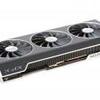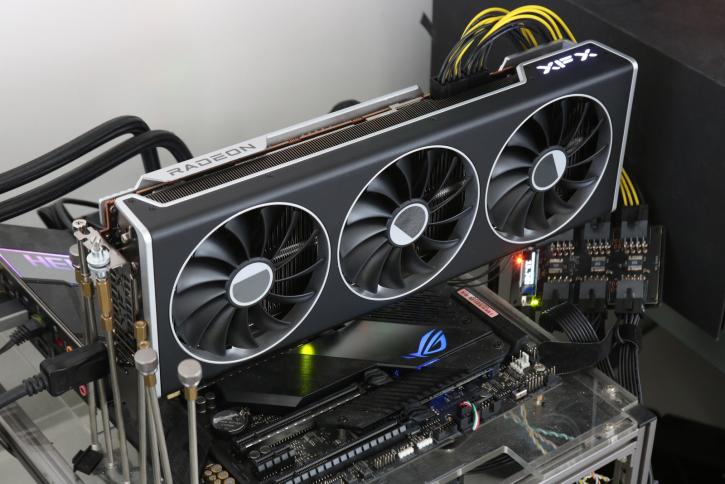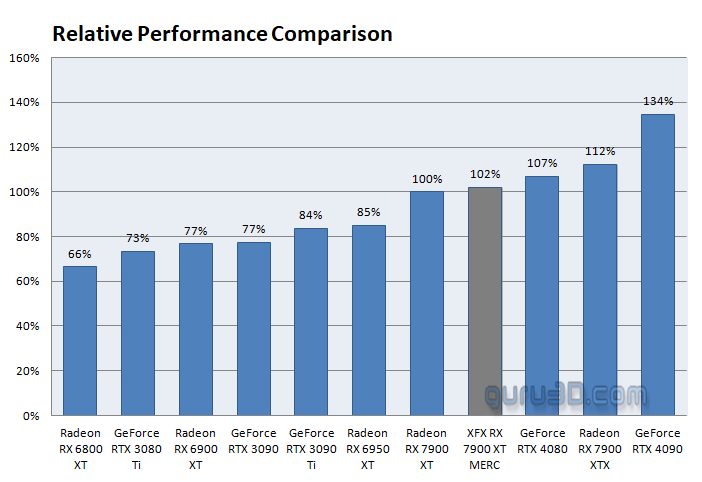Final words and conclusion
Final words
Aside from the acoustic level of this graphics card, XFX did things correctly with the MERC. The result is a professional-looking, high-performance product. I seem to like the XTX model a lot more than the XT. The XTX variant, on the other hand, has significantly more power and appeal with that max power BIOS and a far more extensive factory tweak. At best, the MERC XT will be 2%~3% faster than the reference. It runs excellently chilled and cool, but it isn't quiet. The RX 7900 XT is also a bit difficult to position as it has a few weaknesses. When looking at raw shader performance, it's plenty fast ... closing in at the more expensive GeForce RTX 4080. However, the Achilles heel for the Radeon RX 7900 XT is twofold.
Firstly, AMD relies heavily (perhaps too much) on the extra cache (infinity cache), and caching does help greatly, but primarily for CPU/fillrate/driver-bound situations .. and that's not at a resolution of 3840x2160. So at resolutions up to 2560x1440, AMD can keep up exceptionally well; however, in Ultra HD, where raw brute performance is needed, AMD's graphics engine has difficulty keeping up with the competition. The second Achilles heel is Raytracing performance. While they increased RT perf overall, AMD is not at the same performance level as NVIDIA, as they are making more significant steps with each generational update. The second you enable raytracing in games, combining these two facts drags down UHD performance in such specific render workloads. So that's the sour part. Now that we have established that as a fact, we need to position the card, and here AMD wins; frame for frame rendered AMD has a cheaper (yeah, I said cheaper, not cheap) solution to offer to you. Not just that, if you look at the performance per watt chart, then AMD's engine is highly efficient. Both thus are massive plusses in my book. Whether or not that is enough for you, we can't say; do keep in mind that AMD's Raytracing performance in ultra HD can be enhanced with technologies such as FSR(2). From a raw shader perspective, this product delivers a substantial performance gain over the previous generation. We must also highlight the generational increase in raytracing speed, albeit AMD made smaller steps than NVIDIA did with ADA. Cheaper, not cheap - even at $899, these cards have entered a price range that is no longer attainable to most people. PC gaming has become progressively more expensive, driving end users to other solutions.
Performance
You've seen the numbers, and we've already let the cat out of the bag. It all comes down to gaming performance and, of course, rendering quality. Yes, the RX 7900 XT provides more value for your money than seen from the 4080, as we're getting close to raw performance levels that easily enable gaming at 4K resolution. Most enthusiast gamers play at UWHD, QHD, or UHD monitor resolutions. This card is designed for precisely that kind of gamer. However, we have to say that DLSS3 for the 4080 has significant appeal.
The old rasterizer engine breaks right through the previous limit of extreme performance. Realistically the 7900 XT often sits at the performance level of a 3090 Ti, and here and there at 4080 levels. That's the correct positioning; that also means that the Radeon RX 7900 XT isn't far from the RX 6950 XT. However, compared to the latter, it's far more efficient. Of course, this chart is based on raw shader engine performance; when NVIDIA flicks on Raytracing and DLSS3 with its frame generator, AMD will be left behind, even with FSR2 enabled.
Cooling & noise levels
Initially, we were very happy with the cooling performance of the reference cooler. We see a close to 55-60 degrees C for the XFX MERC 7900 XT, and that's lovely. Acoustics-wise, the card initially cannot be heard; however, after a while, it heats up under heavy load and breaches a more moderate 41-42 DBa. The design for cooling is excellent, with fantastic dark looks, though. Expect the card to get close to 55~60°C when it's stressed with the default BIOS. This value can increase depending on how well air moves through your chassis. FLIR imaging doesn't show anything scary. Also, keep in mind that if you go for a custom card from a board partner, the power consumption levels will likely be higher due to increased TGPs and stuff like RGB and liquid cooling pumps.
Energy
Remember that the Radeon RX 7900 XT is a high-end gaming product that still uses much power. Under full load, the card uses about 300 Watts (336W average TBP). This Wattage is directly related to how much heat the GPU, which sits inside a closed case, gives off.
Coil whine
Any card will exhibit a notch of coil whine once is reaches a high FPS. Is it annoying? It's at a level you can hear it when you hit extremely high framerates. In a closed chassis, that noise would fade away in the background. However, you can hear the coil whine/squeal with an open chassis. Graphics cards all make this in some sort or form, especially at high framerates this can be perceived. It's as good as it can get, and we have not been bothered by it.
Pricing
The reference edition costs USD 899, which is a lot of money still for something that can be used to play PC games. it's however a more appealing offer compared to the RTX 4080 if that MSRP holds ground, and here in we have a lot of doubt. indications are that only a low volume of these cards will be available at launch. This XFX card will cost 979 USD. Now, I can say all kinds of rude things about prices, but these products will still sell no matter what I say. The final EU price would be (depending on country and VAT) RX 7900 XTX / € 1159 and RX 7900 XT / €1049.
Tweaking
The card tweaks well. The power limiter (allowed wattage) at +15% helps out, so that's your first and quickest option to tweak. You get extra perf on the card's default power budget. The boost clock frequency can take a suitable 2800 MHz (frequencies vary per game title as they are dynamic). The memory could be tweaked to 21.5 Gbps, so all these accumulated values brought 4~5% additional performance on challenging GPU situations, measured from reference performance.
Conclusion
We'll keep saying it, but I miss the odd THICC naming:) It was so incorrect that it was good:) But, okay, SpeedSter 319 it is. The card series, however, shares many design aspects with the THICC series, as does the cooler. That also implies that the sizeable 3-fan monster cooler will keep temperatures under control; it, however, is a bit noisier than I had hoped for and strictly speaking, at these temperatures, that isn't necessary. We would have liked to have seen XFX use that second BIOS for a modus operandus that allows, say, 75 Degrees C on the GPU, yet with a more mild fan profile to create a silent product. It's a bit of a missed opportunity. Though rDNA3 is a proper step forward regarding overall performance, efficiency and features, it will remain challenging to battle NVIDIA's flagship product. But as long as the price is right, that's okay as it fills a gap in the market, as prices for enthusiast-class cards are too expensive anyway. The Series 7900 XT product will offer proper Ultra HD performance at a more reasonable price and terrific energy efficiency if you look at (FPS per Watt rendered). However, the cost of ownership is still $899, which likely remains the biggest hurdle. The card excels up to 2560x1440 and then drops off performance at UHD due to a depriving infinity cache effect and lower shader- and raytracing performance. Here's my point, if I were to spend 900 USD, I certainly am not planning to game at lower resolutions; ergo, all performance needs to be at 3840x2160 (and not the lower resolutions). Pricing is crucial, though. For that money, you get a product outputted with the latest monitor ports and a sweet 20 GB of graphic memory. In the end, the Radeon RX 7900 XT offers sensational numbers depending on your resolution and image quality preference. Raytracing is a notch slower than the competition; however, you can make up a lot of performance if that game supports FSR. Price-wise, this card offers good value over the RTX 4080, which starts at $1199. Realistically though, we doubt you'll find the 7900XT at MSRP in the early stages of sales due to limited availability. Regarding the XFX card, we have no grounds for complaint besides reasonable acoustics; it meets all of our requirements. While the GPU temperatures of this card are beautiful, XFX, unfortunately, did not use that 2nd bios for overclocking or a silent profile; we do feel that's a missed opportunity. And that makes all the difference with their XTX model, for sure. Overall it'll run a notch faster than the reference product thigh. At 979 USD, you can pick up this product. We do hope that an ample supply of these products becomes available soon.
- Download AMD Radeon drivers
- Sign up to receive a notification when we publish a new article.
- Or go back to Guru3D's front page
- Hilbert, LOAD"*",8,1.




